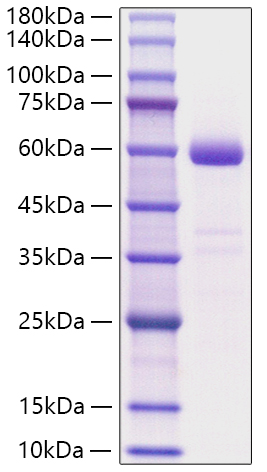Description
Recombinant Human NBL1 Protein
The Recombinant Human NBL1 Protein is a biologically active recombinant protein that plays a significant role in various cellular processes and signaling pathways in human biology. This protein is widely employed in immunological research, cell biology studies, protein-protein interaction analyses, and therapeutic development, providing researchers with a reliable tool for investigating NBL1 function and its implications in health and disease.
This product (SKU: RPCB1212) is produced using HEK293 cells and features a C-hFc tag for convenient detection and purification. The protein exhibits a calculated molecular weight of 43.66 kDa with an observed molecular weight of 60 kDa under denaturing conditions, achieving ≥ 95 % as determined by SDS-PAGE., ensuring exceptional quality and consistency for research applications.
Key Features
| High Purity by Affinity Chromatography | |
| Mammalian & Bacterial Expression Systems | |
| High lot-to-lot consistency via strict QC |
| Product Name: | Recombinant Human NBL1 Protein |
| SKU: | RPCB1212 |
| Size: | 10 μg , 20 μg , 50 μg , 100 μg |
| Reactivity: | Human |
| Synonyms: | NB, DAN, NO3, DAND1, D1S1733E |
| Tag: | C-hFc |
| Expression Host: | HEK293 cells |
| Calculated MW: | 43.66 kDa |
| Observed MW: | 60 kDa |
| Gene ID: | 4681 |
| Protein Description: | High quality, high purity and low endotoxin recombinant Recombinant Human NBL1 Protein (RPCB1212), tested reactivity in HEK293 cells and has been validated in SDS-PAGE.100% guaranteed. |
| Endotoxin: | < 0.01 EU/μg of the protein by LAL method |
| Purity: | ≥ 95 % as determined by SDS-PAGE. |
| Formulation: | Lyophilized from a 0.22 μm filtered solution of PBS, pH 7.4. |
| Reconstitution: | Centrifuge the vial before opening. Reconstitute to a concentration of 0.1-0.5 mg/mL in sterile distilled water. Avoid vortex or vigorously pipetting the protein. For long term storage, it is recommended to add a carrier protein or stablizer (e.g. 0.1% BSA, 5% HSA, 10% FBS or 5% Trehalose), and aliquot the reconstituted protein solution to minimize free-thaw cycles. |
| Storage: | Store at -20℃.Store the lyophilized protein at -20℃ to -80 ℃ up to 1 year from the date of receipt. After reconstitution, the protein solution is stable at -20℃ for 3 months, at 2-8℃ for up to 1 week. |
The Dan (Differential screening-selected gene aberrative in neuroblastoma, also known as N03) gene was first identified as the putative rat tumor suppressor gene and encodes a protein structurally related to Cerberus and Gremlin in the vertebrates. It is a founding member of the DAN family of secreted proteins, acts as an inhibitor of cell cycle progression, and is closely involved in retinoic acid-induced neuroblastoma differentiation. There are at least five mammalian protein members in the evolutionarily conserved Dan family including DAN, Gremlin/DRM, Cer1 (Cerberus-related), Dante, and PRDC (protein related to DAN and Cerberus), and share the C-terminal cystine-knot motif. As a secreted glycoprotein, DAN is a member of a class of glycoproteins shown to be secreted inhibitors of the transforming growth factor-beta (TGF-beta) and bone morphogenic protein pathways. It binds to BMPs and preventing their interactions with signaling receptor complexes, and accordingly regulates the processes of embryonic development and tissue differentiation. DAN gene product may have an important role in the regulation of the entry of cells into the S phase. Besides, the DAN gene product possesses an ability to revert phenotypes of transformed rat fibroblasts and represents a candidate tumor suppressor gene for neuroblastoma.







